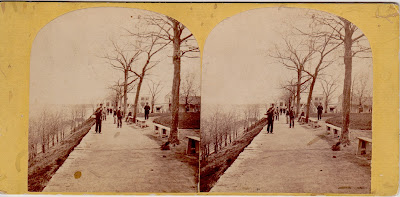Michael O'Hara speculated, in a comment on yesterday's post, that the structure may have been a "public weather station," enabling people to see the direction and speed of the wind at the riverfront from almost any point in the city. A report on a Common Council meeting that appeared in the Hudson Evening Register on August 9, 1898, indicates that at that time, there was no flagpole on Promenade Hill, although there was a lot of talk about putting one there. At the time, an ad hoc committee had solicited estimates for a flagpole with and without a weather vane.
Pursuing the possibility of a weather vane, Chad Weckler guided Gossips to the following report on the Common Council meeting that took place in April 1901. The report, which appeared in the Hudson Evening Register for April 26, 1901, tells of a resolution having to do with the flag staff on Promenade Hill, which was vetoed by then mayor Charles S. Harvey.
[Gossips Note: Back when I was reading Common Council minutes from 1909 and 1910, searching for any mention of the Hudson-Fulton fountain, I was struck by how often the mayor at the time, James C. Armstrong, vetoed Common Council actions. This seems to have been common at that time. In April 1901, his predecessor, Charles Harvey, vetoed a total of four Council resolutions. Our interest is with just one of them.]
Hudson, April 15, 1901.
To the Common Council:
Gentleman:--I do hereby disapprove of the resolution offered by Ald. Roach and passed by your honorable body on April 11, 1901, which reads as follows:
Resolved, That the Fire committee be authorized to have the flag staff on Promenade hill cleaned and painted and raised and a larger weather vane placed on the same at an expense not to exceed $60.
My reason for disapproving of this is that I have been informed by different contractors that make a business of this line of work that this work can be done for less than half of the amount appropriated. Two years ago this same work was done for $25 as the proceedings of the Common Council show, and I cannot seen the necessity of appropriating this amount, and do hereby veto the same.
Charles S. Harvey, Mayor
Ald. Roach stated that he was in favor of having the flag-staff repaired and re-gilded twice this summer if necessary, as thousands of people would pass along the river this year on their way to the Pan-American. The weather-vane had been enlarged and the flag-staff instead of receiving a coat of paint, would receive two coats of milk-white paint. Every day during the summer the flag should fly from its high altitude, the same as was done at Washington's headquarters in Newburgh. Travelers seeing Old Glory flying would make inquires as to what city it was and it would certainly help keep Hudson in their minds. The original motion was then passed over the Mayor's veto by the same vote as the first vote--8 to 2.The "Pan-American" mentioned by Alderman Roach was the Pan-American Exposition that took place in Buffalo from May 1 to November 2, 1901. Buffalo, then the eighth largest city in the country, was selected as the site for the exposition because of its railway connections, and a great feature of the event was the Electric Tower and many other buildings covered with light bulbs and illumined by the hydroelectric power generated at Niagara Falls.
It was at the Pan-American Exposition that President William McKinley was assassinated, shot twice by Leon Czolgosz on September 6 and ultimately dying on September 14 from infection and gangrene.
The University at Buffalo website is a rich source of information about the Pan-American Exposition, and you can make your own virtual visit at a website called Doin' the Pan. If you like to experience history through historical fiction, City of Light, by Lauren Belfer, published in 1999, is set in Buffalo during the Pan-American Exposition and does a good job of creating a sense of time and place.
COPYRIGHT 2013 CAROLE OSTERINK





It's an interesting question whether a Common Council resolution concerning a property which is actually *owned* by the council - such as the Promenade Park, or facilities as permitted in the Charter - can be vetoed by the mayor?
ReplyDeleteWhat are the parliamentary rules in that case?
It's worth noting that I'm getting resistance from the city while trying to answer a parallel question:
DeleteDoes a mayor have independent authority to commit actions on, in or to a property that's technically owned by the Common Council?
I argue that just such an action took place recently on a council-owned property. Because it didn't come before our representatives on the council, wasn't the action unauthorized?
Anyone else care to learn the rules? If not, why not?
unheimlich--Although I don't have the answers to your questions, I think in the case of this veto, the mayor was objecting to the amount of money being allocated to the project not to the Common Council's right to make improvements to Promenade Hill.
DeleteVery true Gossips - about the 1901 case.
DeleteI guess that my comments above are officially "O.T.," except what better time to discuss such things?
The reply I got to parliamentary question I posed to the city was basically the following: "judging entirely from personal our interests, some of us think you're wrong. So if you're not going to sue us then stop being a nuisance."
I say that they're wrong, but who cares, right?
a gilded flag pole- must have been stunning
ReplyDelete